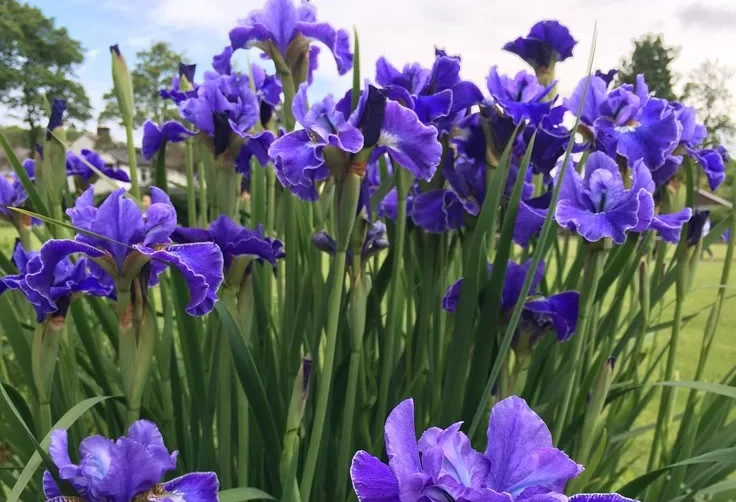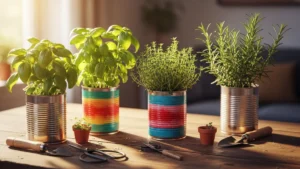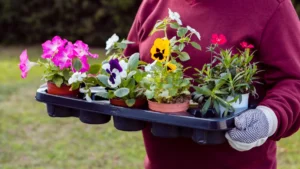When it comes to cultivating dazzling iris flowers, choosing the right iris plant fertilizer makes all the difference.
These stunning perennials, with their sword-shaped leaves and colorful blossoms, need proper nutrients to thrive. Therefore, applying the correct fertilizer at the right time can transform your garden into a vibrant display of life and color.
In this complete guide, you’ll learn which fertilizers work best for irises, how to apply them effectively, and what common mistakes to avoid. Let’s dive in to make your iris garden flourish!
Why Fertilizing Irises Matters
Fertilizing irises is essential because it replenishes soil nutrients that are depleted after each growing cycle. Over time, soil loses key minerals like nitrogen, phosphorus, and potassium—each vital for growth, root development, and flower production.
Without proper feeding, irises may develop dull foliage, weak stems, or smaller blooms. Hence, a balanced fertilization plan ensures long-lasting beauty and health for your plants.
Additionally, well-fertilized irises are more resistant to pests and diseases. This natural protection reduces maintenance work and promotes sustainable gardening.
Best Time to Apply Iris Plant Fertilizer

Timing plays a major role in effective iris fertilization. Ideally, you should fertilize twice a year:
-
Early Spring: Just as new growth appears, apply a balanced, slow-release fertilizer. This helps stimulate root and leaf growth.
-
After Blooming (Late Summer): Apply a low-nitrogen fertilizer to prepare the plant for dormancy and next year’s bloom cycle.
Transitioning between these stages smoothly ensures consistent nourishment without overstressing the plant.
Types of Iris Plant Fertilizer
Understanding the different types of iris plant fertilizer helps you select the most effective option for your specific soil conditions and iris variety. Moreover, each fertilizer type offers unique benefits and application methods, so knowing when and how to use them ensures optimal growth. In addition, using the right type can prevent common issues such as nutrient deficiency or root burn, leading to healthier, more vibrant blooms.
1. Granular Fertilizers
Granular fertilizers are among the most common choices for iris growers. Not only are they easy to apply, but also they release nutrients gradually, ensuring consistent feeding over time. Typically, these fertilizers are sprinkled evenly around the base of the plant and then watered thoroughly to help nutrients penetrate the soil.
Furthermore, granular fertilizers are ideal for gardeners who prefer low-maintenance care, as they don’t require frequent reapplication. However, be careful not to place the granules directly on the rhizomes, since concentrated contact can cause burns. Overall, they’re perfect for sustained growth and long-term soil enrichment.
2. Liquid Fertilizers
Liquid fertilizers are fast-acting and deliver nutrients directly to the plant’s root zone. Consequently, they are an excellent choice when your irises need a quick nutrient boost, especially during active growth or early blooming stages. Because they can be absorbed through both the roots and leaves, they provide visible results much faster than slow-release varieties.
Additionally, liquid fertilizers can be easily diluted and applied using a watering can or sprayer, making them highly convenient. However, since they are quickly used up by the plant, you may need to reapply them every few weeks. Therefore, maintaining a consistent feeding schedule ensures steady development and vibrant flower production.
3. Organic Fertilizers
For eco-conscious gardeners, organic fertilizers are a natural and sustainable option. They include materials such as compost, bone meal, fish emulsion, and seaweed extract. These organic sources not only feed the irises but also enrich the soil, promoting microbial activity and improving its overall structure.
Moreover, organic fertilizers release nutrients slowly, providing long-term nourishment without the risk of overfeeding. As a result, they encourage steady growth and enhance the natural fertility of your garden. In particular, composted manure and bone meal are great for improving phosphorus content, which is essential for strong root development.
On the other hand, organic fertilizers may take longer to show visible effects compared to synthetic ones. Nevertheless, they create a healthier and more balanced soil ecosystem over time, which benefits your irises in the long run.
4. Synthetic Fertilizers
Synthetic fertilizers are chemically formulated to deliver precise nutrient ratios for rapid growth. Because of this, they are especially useful when your irises show signs of nutrient deficiency or stress. For example, a synthetic 10-10-10 blend can instantly restore balance and stimulate flowering.
However, synthetic fertilizers must be applied with caution. Excessive use can lead to salt buildup in the soil, which may damage delicate iris roots. Therefore, always follow the manufacturer’s recommended application rate and water thoroughly afterward to flush away excess salts.
In addition, synthetic fertilizers provide uniform results and are ideal for gardeners who want predictable performance. Still, alternating between synthetic and organic feedings can help maintain both short-term effectiveness and long-term soil health.
Choosing the Right Fertilizer for Your Garden
Ultimately, the best iris plant fertilizer depends on your gardening goals and soil type. If you prefer a low-maintenance option, go for granular or slow-release formulas. Alternatively, if your plants need an immediate boost, liquid fertilizers are the best solution. Meanwhile, those focused on sustainability should stick to organic fertilizers for their long-term benefits.
For instance, learning from guides like the Ixora plant fertilizer recommendations can help you choose nutrient blends that enhance soil health and flower quality effectively. Above all, understanding the unique characteristics of each fertilizer type allows you to make informed decisions that promote healthier, stronger, and more colorful iris blooms season after season.
Iris Plant Fertilizer: Choosing the Right NPK Ratio for Irises

The NPK ratio (Nitrogen-Phosphorus-Potassium) is crucial in selecting the correct iris plant fertilizer.
-
Nitrogen (N) encourages lush leaf growth.
-
Phosphorus (P) supports strong root systems and vibrant blooms.
-
Potassium (K) improves plant health and resistance to diseases.
A 10-10-10 or 5-10-10 fertilizer works best. The slightly lower nitrogen prevents excess leafy growth at the expense of flowers. Furthermore, using too much nitrogen can cause rot in iris rhizomes. Therefore, moderation is key for balance.
How to Apply Iris Plant Fertilizer Correctly
Proper application ensures maximum nutrient absorption and minimal waste.
-
Clean the Bed: Remove weeds and debris around the rhizomes.
-
Apply Fertilizer Evenly: Spread around the root zone—never directly on the rhizome.
-
Water Thoroughly: This helps nutrients soak into the soil and reduces the risk of burns.
-
Mulch Lightly: Maintain soil moisture while preventing nutrient runoff.
By following these steps, your irises will absorb nutrients effectively and bloom with vigor.
Iris Plant Fertilizer: Common Mistakes to Avoid
Even experienced gardeners make fertilizing errors. Avoid the following pitfalls:
-
Over-fertilizing: Too much fertilizer burns roots and weakens the plant.
-
Wrong Timing: Late fall fertilizing can stimulate growth before frost, leading to damage.
-
Ignoring Soil pH: Irises prefer slightly acidic to neutral soil (6.5–7.0 pH).
-
Skipping Watering: Without moisture, nutrients remain unused in dry soil.
Remember, balance and consistency produce the best results.
Natural Alternatives to Chemical Fertilizers
If you prefer an organic approach, there are many natural fertilizers you can use:
-
Compost: Enriches soil gradually and improves drainage.
-
Bone Meal: Provides phosphorus for strong roots.
-
Seaweed Extract: Enhances potassium and boosts flower color.
-
Manure: Adds slow-releasing nutrients, but ensure it’s well-composted.
These eco-friendly options promote long-term soil health and reduce environmental impact.
Signs Your Irises Need Fertilizer

Recognizing the signs of nutrient deficiency helps you act in time:
-
Pale or yellowing leaves
-
Few or no blooms
-
Weak stems that easily bend
-
Stunted growth or poor root development
Once you notice these symptoms, apply a balanced iris plant fertilizer immediately to restore vitality.
Frequently Asked Questions (FAQs)
1. What is the best fertilizer for iris plants?
A 10-10-10 or 5-10-10 fertilizer works best. It offers balanced nutrition while preventing overgrowth of leaves.
2. Can I use compost instead of chemical fertilizer?
Yes, compost is a great organic alternative. It improves soil structure and supports natural growth without chemical buildup.
3. How often should I fertilize irises?
Twice a year—once in early spring and again after flowering—is ideal. Avoid fertilizing in late fall or winter.
4. Can over-fertilizing harm my irises?
Absolutely. Over-fertilizing can burn roots, encourage rot, and delay blooming. Always follow product instructions carefully.
5. Is liquid fertilizer good for iris plants?
Yes, especially during active growth. Liquid fertilizers provide quick nutrient absorption, helping plants recover faster after blooming.
Iris Plant Fertilizer: Conclusion
Feeding your irises with the right iris plant fertilizer is the secret to maintaining a garden filled with color, health, and vitality. Moreover, it ensures that your plants stay resilient throughout the changing seasons. Whether you prefer organic or synthetic options, consistency and timing are key. In addition, remember to apply the right NPK balance, water adequately, and avoid over-fertilizing. If you ever notice issues like leaf discoloration or yellowing, similar to what can happen with other plants, you can check out this helpful guide on peace lily yellow leaves to better understand the causes and remedies.
Furthermore, proper fertilization not only boosts bloom quality but also strengthens root systems for long-term growth. Consequently, your irises become more resistant to diseases and harsh weather conditions. Additionally, maintaining soil health plays a vital role in continuous nourishment. Therefore, testing your soil before each growing season is highly recommended.
Likewise, using mulch and compost enhances moisture retention, while simultaneously improving nutrient absorption. As a result, your garden becomes more balanced and self-sustaining. In conclusion, by nurturing your irises thoughtfully and consistently, you’ll enjoy radiant blooms and thriving plants season after season indeed, proof that proper fertilization truly makes a lasting difference.


















